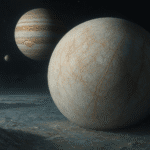Saturn’s largest moon beckons scientists with its thick atmosphere and liquid hydrocarbon seas, offering a glimpse into alien processes that could reshape our understanding of planetary bodies. Beneath its orange haze lies a world both familiar and utterly strange, where weather patterns echo Earth’s, yet the materials and temperatures are profoundly different. This exploration of Titan delves into its enigmatic landscape, atmospheric mysteries, and the ambitious missions poised to unravel its secrets.
The Enigmatic Landscape
Titan’s surface reveals a tapestry of dunes, mountains, and vast lakes filled not with water but with liquid methane and ethane. Radar imaging from the Cassini orbiter sketched river channels that snake toward shoreline basins, suggesting a hydrological cycle driven by seasonal rains of hydrocarbons. Dark equatorial regions host longitudinal dunes composed of organic grains, sculpted by prevailing winds. Polar regions, in contrast, display coastlines and islands amid sprawling seas, making Titan the only celestial body besides Earth known to possess stable surface liquids.
Mountains on Titan rise hundreds of meters, their composition likely involving ice-rock mixtures. The interplay between solid ice, organic sediments, and liquid hydrocarbons creates dynamic geological features. Cryovolcanism has been proposed as another force shaping this moon: icy “volcanoes” could erupt slushy water-ammonia mixtures, resurfacing areas and contributing to the atmospheric composition. Each feature invites questions about Titan’s internal heat source, subsurface ocean potential, and long-term evolution.
Probing the Atmospheric Mysteries
Encased in a thick nitrogen-rich atmosphere, Titan boasts a pressure greater than Earth’s at sea level. Sunlight triggers photochemical reactions high in the haze layers, converting nitrogen and methane into a complex soup of organic molecules. Aerosols formed in the upper atmosphere drift downward, eventually settling as a smog-like coating on the surface. These organics could offer clues about prebiotic chemistry, hinting at pathways leading to biomolecular precursors.
Huygens, Europe’s pioneering probe, descended through Titan’s clouds in 2005, transmitting invaluable data on temperature, wind speeds, and chemical composition. It detected stable layers of haze and winds reaching speeds of up to 10 meters per second. Methane droplets and possible ethane rains were inferred from surface wetting patterns. Understanding these processes is crucial for discerning seasonal shifts, weather dynamics, and the fate of hydrocarbons cycling between atmosphere and surface.
Future Missions and Scientific Implications
Building on Cassini–Huygens triumphs, upcoming missions aim to deepen our grasp of Titan’s secrets. The primary objectives include mapping the subsurface ocean, sampling surface organics, and assessing potential habitability. These goals demand innovative technologies capable of operating in frigid conditions near 94 K.
- Dragonfly: A rotorcraft lander slated for launch in the mid-2020s, designed to fly to multiple sites, analyze organic chemistry, and measure environmental parameters.
- TiME (Titan Mare Explorer): A proposed floating probe to study the composition and depth of Ligeia Mare, one of Titan’s largest lakes.
- International Collaborations: Joint missions focusing on ice-penetrating radar to characterize the subsurface ocean, and advanced spectrometers to detect complex organics.
These endeavors could illuminate Titan’s potential as a prebiotic laboratory, revealing whether the raw materials and energy sources coexist to foster life-like chemistry. By comparing Titan’s organic-rich environment with early Earth conditions, scientists hope to refine models of abiogenesis and the emergence of biology under diverse planetary scenarios.
Scientific Frontiers and Challenges
Operating in Titan’s extreme environment poses formidable challenges. Electronics must withstand cryogenic temperatures and resist contamination by hydrocarbons. Communication delays and limited solar power near Saturn necessitate robust autonomous systems. Yet the potential rewards are immense: unlocking Titan’s mysteries could revolutionize our grasp of planetary science and extend the search for life to the most unexpected corners of the solar system.
As humanity extends its reach to distant worlds, Titan stands as a testament to the diversity of planetary processes. Its combination of exploration potential, complex chemistry, and geophysical dynamics underscores the enduring allure of the cosmic frontier. Each discovery paves the way toward a richer understanding of how worlds form, evolve, and perhaps harbor the precursors of life.










